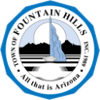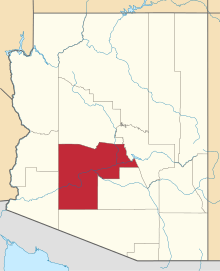Fountain Hills, Arizona
| Fountain Hills, Arizona | ||
|---|---|---|
| Town | ||
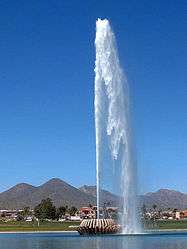 The fountain of Fountain Hills can spew water to a height of up to 560 feet (170 m) | ||
| ||
| Motto(s): "All That Is Arizona"[1] | ||
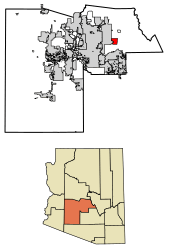 Location of Fountain Hills in Maricopa County, Arizona | ||
 Fountain Hills, Arizona Location in the United States | ||
| Coordinates: 33°36′N 111°43′W / 33.60°N 111.72°WCoordinates: 33°36′N 111°43′W / 33.60°N 111.72°W | ||
| Country | United States | |
| State | Arizona | |
| County | Maricopa | |
| Incorporated | 1989 | |
| Government | ||
| • Mayor | Linda Kavanagh | |
| Area[2] | ||
| • Total | 20.36 sq mi (52.73 km2) | |
| • Land | 20.27 sq mi (52.50 km2) | |
| • Water | 0.09 sq mi (0.23 km2) | |
| Elevation | 1,905–2,100 ft (580–640 m) | |
| Population (2010)[3] | ||
| • Total | 22,489 | |
| • Estimate (2016)[4] | 24,482 | |
| • Density | 1,207.74/sq mi (466.30/km2) | |
| Time zone | UTC-7 (MST (no DST)) | |
| ZIP codes | 85268-85269 | |
| Area code(s) | 480 | |
| FIPS code | 04-25300 | |
| Website | Town of Fountain Hills, Arizona | |
Fountain Hills is a town in Maricopa County, Arizona, United States. Known for its impressive fountain, once the tallest in the world, it borders on the Fort McDowell Yavapai Nation, Salt River Pima-Maricopa Indian Community, and Scottsdale, Arizona. The population is 22,489, as of the 2010 census.[3] Between the 1990 and 2000 censuses it was the eighth-fastest-growing place among cities and towns in Arizona.
History
Before the development of Fountain Hills, the area was home to the Yavapai, and petroglyphs can be found near the Dixie Mine in the northwest corner of the town along the mountains.

In the early 1900's, the area that became Fountain Hills and the McDowell Mountain Regional Park was part of the Pemberton Ranch[5], later renamed the P Bar Ranch. Fountain Hills High School is built on the site of one of the P Bar Ranch's buildings, and a plaque stands in the parking lot to commemorate this.

Fountain Hills was developed by C. V. Wood, president of McCulloch Oil, and was named after the towering man-made fountain in the center of town.[6][7] It was incorporated in 1989.[8]
Geography
According to the United States Census Bureau, the town has a total area of 18.2 square miles (47.1 km2), of which 18.1 square miles (46.9 km2) is land and 0.1 square mile (0.26 km2) (0.55%) is water.
To the east of the town is the Verde River, a tributary to the Salt River. Inside the town there are many washes that run through Fountain Hills into the Verde River. Some of these washes include the Ashbrook, Balboa, Legend, and Colony Washes. During times of rain the washes flood with water and can sometimes block roads with their water. Signs mark several of the intersections of washes and major streets in the town.
To the southwest and northwest regions of Fountain Hills are the McDowell Mountains, a chain of extinct volcanic mountains. The highest mountains in the range are East End (4,033 ft (1,229 m)) and Thompson Peak (3,910 ft (1,190 m)).
Climate
This area has a large amount of sunshine year round due to its stable descending air and high pressure. According to the Köppen Climate Classification system, Fountain Hills has a hot desert climate, abbreviated "Bwh" on climate maps.[9]
Demographics
| Historical population | |||
|---|---|---|---|
| Census | Pop. | %± | |
| 1980 | 2,771 | — | |
| 1990 | 10,030 | 262.0% | |
| 2000 | 20,235 | 101.7% | |
| 2010 | 22,489 | 11.1% | |
| Est. 2016 | 24,482 | [4] | 8.9% |
| U.S. Decennial Census[10] | |||
As of the census of 2010, there were 22,489 people, 10,339 households, and 7,121 families residing in the town. The population density was 1,113.8 inhabitants per square mile (430.0/km2). There were 13,167 housing units at an average density of 577.5 per square mile (223.0/km2). The ethnic makeup of the town was 94.1% White, 1.0% Black or African American, 0.6% Native American, 1.8% Asian, 0.1% Native Hawaiian and Other Pacific Islander, 1.1% from other races, and 1.4% from two or more races. Hispanic or Latino of any race make up 4.1% of the population.
There were 10,339 households out of which 18.6% had children under the age of 18 living with them, 59.4% were married couples living together, 6.7% had a female householder with no husband present, and 31.1% were non-families. Householders living alone make up 25.7% of all households and 11.5% had someone living alone who was 65 years of age or older. The average household size was 2.16 and the average family size was 2.56.
In the town, the population was spread out with 14.4% under the age of 18, 85.6% 18 years and over, and 27.8% who were 65 years of age or older. The median age was 53.9 years. There were 47.8% males and 52.2% females.
According to a 2010 Census American Community Survey 3-year estimate, the median income for a household in the town was $75,038, and the median income for a family was $91,585.[11]
The per capita income for the town was $47,441. About 3.0% of families and 5.0% of the population were below the poverty line, including 8.6% of those under age 18 and 0.7% of those age 65 or over.
Arts and culture
The Fountain
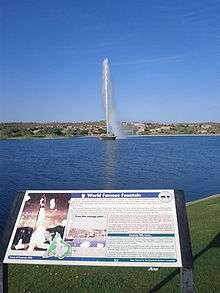
Fountain Hills has the world's fourth-tallest fountain. It was built in 1970, by Robert P. McCulloch, the year before the reconstruction of the London Bridge in Lake Havasu City, another of McCulloch's projects. The fountain sprays water for about 15 minutes every hour between 9am and 9pm. The plume rises from a concrete water-lily sculpture in the center of a large man-made lake. The fountain, driven by three 600 horsepower (450 kW) turbine pumps, sprays water at a rate of 7,000 US gallons (26,000 l; 5,800 imp gal) per minute through an 18-inch (460 mm) nozzle. With all three pumps under ideal conditions, the fountain reaches 560 feet (170 m) in height,[12] though in normal operation only two of the pumps are used, with a fountain height of around 300 feet (91 m). When built it was the world's tallest fountain, a record it held for over a decade.[13]
Annual fairs
The town has three annual fairs—a local art fair, the Fountain Hills Great Fair, which incorporates arts and a carnival, and the Thunderbird Artists' Fountain Hills Fine Art & Wine Affaire. Each year the town's fountain is dyed green in celebration of St. Patrick's day.[14] Fountain Hills Theater is an award-winning performing arts venue entering its 28th season and offering over 16 productions a year to local communities as well as performing an arts education year round for youth.
Government
Fountain Hills has a council-manager system. The current mayor of Fountain Hills is Linda Kavanagh, elected in Mar 2012 after running in an uncontested election for the seat vacated by Jay Schlum. The current Town Council consists of the mayor and six councilmembers: Councilmembers Henry Leger, Dennis Brown, Alan Magazine, Cecil Yates, Nick DePorter and Art Tollis. Grady Miller is the Town Manager. Among other council appointed staff are Town Attorney Andrew McGuire and Town Magistrate Robert Melton.
The town contracts its law enforcement services with the Maricopa County Sheriff's Office.
Fountain Hills' Fire Department has two fire stations and contracts with Rural Metro for staffing of its fire department. Dave Ott is the Fire Chief.
Fountain Hills is in Arizona's 6th Congressional District, served by Representative David Schweikert and Arizona's 23rd State Legislative District served by Representatives Jay Lawrence and Michelle R. Ugenti and Senator John Kavanagh, all Republicans.
Education
Fountain Hills Public Schools are part of the Fountain Hills Unified School District #98. The district has two elementary schools, one middle school and one high school. StudentsFountain Hills High School.[15]
Media
The Fountain Hills Times is the town's weekly newspaper and is published in Fountain Hills.[16] The paper has a weekly circulation of about 3,000.[17]
The parent company of the Times, Western States Publishers, Inc., also publishes the Fountain Hills/Rio Verde Telephone Directory, Fountain Hills Community Guide, Fountain Hills HOME.[18]
Notable people
- Joe Arpaio – former sheriff of Maricopa County
- Kathy Ahern – professional golfer
Sister cities
Fountain Hills has four sister cities, as designated by Sister Cities International: [19]
Gallery
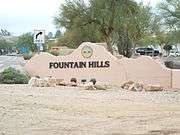
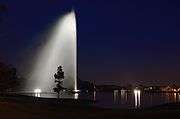

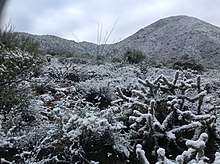
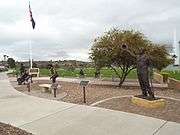
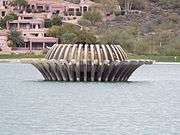
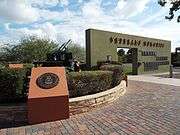
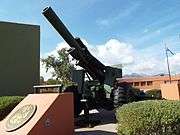
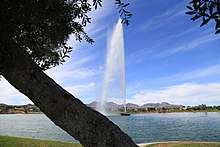
The Stoneman Road, established by Colonel George Stoneman, was an important supply road between Fort McDowell and Fort Whipple in Prescott between 1870 and 1890 on what is today the Yavapai Reservation near Fountain Hills. The trail passed through the McDowell Mountains. The McDowell Mountains is a chain of extinct volcanic mountains in Fountain Hills.[20]
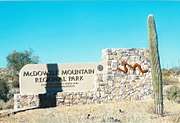
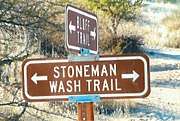
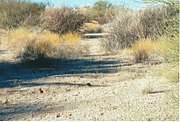
References
- ↑ "Town of Fountain Hills, Arizona". Town of Fountain Hills, Arizona. Retrieved August 23, 2012.
- ↑ "2016 U.S. Gazetteer Files". United States Census Bureau. Retrieved July 18, 2017.
- 1 2 "American FactFinder". United States Census Bureau. Retrieved July 10, 2014.
- 1 2 "Population and Housing Unit Estimates". Retrieved June 9, 2017.
- ↑ https://arizona.hometownlocator.com/maps/feature-map,ftc,2,fid,32778,n,pemberton%20ranch.cfm
- ↑ Arroyo Rodriguez, Nadine (April 18, 2014). "Did You Know: The Fountain Hills Namesake Is Among The World's Largest". KJZZ. Retrieved July 17, 2016.
- ↑ "Profile for Fountain Hills, Arizona, AZ". ePodunk. Retrieved August 23, 2012.
- ↑ "Town of Fountain Hills, Arizona". Town of Fountain Hills, Arizona. Retrieved August 23, 2012.
- ↑ Climate Summary for Fountain Hills, Arizona
- ↑ "Census of Population and Housing". Census.gov. Retrieved June 4, 2016.
- ↑ "Selected Economic Characteristics (DP03): Fountain Hills, Arizona". Retrieved May 11, 2012.
- ↑ "The Fountain". Archived from the original on July 22, 2011. Retrieved October 26, 2011.
- ↑ "The Fountain (site disabled 2017-06-26)". Fountain Hills Guide. Retrieved August 23, 2012.
- ↑ "The Fountain". Fountain Hills Guide. Retrieved August 23, 2012.
- ↑ "Fountain Hills United School District #98". Fountain Hills United School District #98. Retrieved August 23, 2012.
- ↑ "Fountain Hills Times". Fountain Hills Times. Retrieved August 23, 2012.
- ↑ "National Newspaper Association 2012 Better Newspaper Contest Winners" (PDF). National Newspaper Association. Retrieved August 23, 2012.
- ↑ "Fountain Hills Times CO". Yellowpages. Retrieved August 23, 2012.
- ↑ "Interactive City Directory". Sister Cities International. Archived from the original on August 23, 2016. Retrieved August 23, 2016.
- ↑ Arizona Republic
External links
- Fountain Hills City website
- "Fountain Hills Chamber of Commerce". Retrieved October 26, 2011.
- "Fountain Hills Times Newspaper". Retrieved October 26, 2011.
- "Fountain Hills School District". Retrieved October 26, 2011.
- "Fountain Hills Charter School". Retrieved October 26, 2011.
